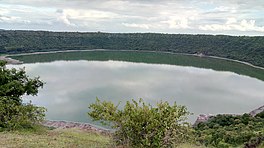
Back بحيره لونار كراتير ARZ Лонар CV Lonar-See German Cratère de Lonar French લોનાર ઉલ્કા તળાવ Gujarati लोनार झील Hindi Danau kawah Lonar ID Lago del cratere Lonar Italian ಲೋಣಾರ್ ಸರೋವರ Kannada ലോനാർ ഗർത്തം Malayalam
| Lonar Lake | |
|---|---|
 View of Lonar crater (Buldhana district, Maharashtra) from the rim | |
| Location | Lonar, Buldhana district, Maharashtra, India |
| Coordinates | 19°58′30″N 76°30′27″E / 19.97500°N 76.50750°E |
| Type | impact crater lake, salt lake |
| Basin countries | |
| Max. length | 1,830 m (6,000 ft) |
| Surface area | 1.13 km2 (0.44 sq mi) |
| Average depth | 137 m (449 ft) |
| Max. depth | 150 m (490 ft) |
| Water volume | 0.15 km3 (0.036 cu mi) |
| Residence time | IST |
| Surface elevation | 480 m (1,570 ft) |
| Settlements | Lonar, near Buldhana city |
| References | earthobservatory |
| Designated | 22 July 2020 |
| Reference no. | 2441[1] |
Lonar Lake, also known as Lonar crater, is a saline, soda lake, located at Lonar, 79 km from Buldhana city in Buldhana district, Maharashtra, India. It is a notified National Geo-heritage Monument.[2][3][4]
Lonar Lake is in an astrobleme created by a meteorite impact during the Pleistocene Epoch.[5][6] It is one of only four known hyper-velocity impact craters in basaltic rock anywhere on Earth. The other three basaltic impact structures are in southern Brazil.[7] Lonar Lake has a mean diameter of 1.2 kilometres (3,900 ft) and is about 137 metres (449 ft) below the crater rim. The meteor crater rim is about 1.8 kilometres (5,900 ft) in diameter.[8]
Although the crater's age was previously estimated to be 52,000 ± 6,000 years,[9] newer studies suggest an age of 576,000 ± 47,000 years.[10][11]
Lonar Crater sits inside the Deccan Plateau – a massive plain of volcanic basalt rock created by eruptions some 65 million years ago. Its location in this basalt field suggested to some geologists that it was a volcanic crater. Today, however, Lonar Crater is understood to be the result of a meteorite impact.[12] The water in the lake is both saline and alkaline.
Geologists, ecologists, archaeologists, naturalists and astronomers have published studies on various aspects of the ecosystem of this crater lake.[13]
The Smithsonian Institution, the United States Geological Survey, Geological Survey of India, the University of Sagar and the Physical Research Laboratory have conducted extensive studies of the site.[14][15] Biological nitrogen fixation was discovered in this lake in 2007.[16]
A 2019 study, conducted by IIT Bombay found that the minerals in the lake soil are very similar to the minerals found in Moon rocks brought back during the Apollo Program.[17] The lake was declared a protected Ramsar site in November 2020.[18]
- ^ "Lonar Lake". rsis.ramsar.org. Ramsar Sites Information Service. Retrieved 14 November 2020.
- ^ "National Geological Monument". portal.gsi.gov.in. Geological Survey of India. Archived from the original on 12 July 2017. Retrieved 23 May 2017.
- ^ "Geo-Heritage Sites". pib.nic.in.
- ^ national geo-heritage of India Archived 11 January 2017 at the Wayback Machine, INTACH
- ^ "Geology". Government of Maharashtra. Gazetteers Department. Retrieved 8 September 2008.
- ^ "Lonar Lake, Buldana District, Maharashtra". Geological Survey of India. Archived from the original on 27 July 2009. Retrieved 8 September 2008.
- ^ Crósta, A.P.; Reimold, W.U.; Vasconcelos, M.A.R.; Hauser, N.; Oliveira, G.J.G.; Maziviero, M.V.; Góes, A.M. (April 2019). "Impact cratering: The South American record – Part 1". Geochemistry. 79 (1): 1–61. Bibcode:2019ChEG...79....1C. doi:10.1016/j.chemer.2018.06.001. S2CID 134656351.
- ^ Deshpande, Rashmi (3 December 2014). "The Meteor Mystery Behind Lonar Lake". National Geographic Traveller India. National Geographic Group. Archived from the original on 6 January 2015. Retrieved 27 July 2015.
- ^ "Lonar". Earth Impact Database. Planetary and Space Science Centre University of New Brunswick Fredericton. Retrieved 30 December 2008.
- ^ Jourdan, Fred; Moynier, Frederic; Koeberl, Christian; Eroglu, Sümeyya (2011). "40Ar/39Ar age of the Lonar crater and consequence for the geochronology of planetary impacts". Geology. 39 (7): 671–674. Bibcode:2011Geo....39..671J. doi:10.1130/G31888.1.
- ^ Schmieder, Martin; Kring, David A. (2020). "Earth's impact events through geologic time: A List of Recommended Ages for Terrestrial Impact Structures and Deposits". Astrobiology. 20 (1): 91–141. Bibcode:2020AsBio..20...91S. doi:10.1089/ast.2019.2085. PMC 6987741. PMID 31880475.
- ^ Dhayade, Kundan, ed. (29 November 2004). "Earth observatory NASA". earthobservatory.nasa.gov.
- ^ Malu, Ram (18 December 2002). "Lonar crater saline lake, an ecological wonder in India". International Society for Salt Lake Research. Archived from the original on 6 October 2014. Retrieved 8 September 2008.
{{cite web}}: CS1 maint: unfit URL (link) - ^ "Lonar". The Planetary and Space Science Center. University of New Brunswick. Archived from the original on 24 September 2015. Retrieved 8 September 2008.
- ^ Babar, Rohit. "Lonar, A Gem of Craters". Office of Space Science Education. Archived from the original on 16 March 2012. Retrieved 8 September 2008.
- ^ Avinash A. Raut and Shyam S. Bajekal; Nitrogen Fixing Bacteria from Hypervelocity meteorite impact Lonar Crater; in Special Issue of Research Journal of Biotechnology; December 2008 and Avinash A. Raut and Shyam S. Bajekal; "Nitrogen Fixing Actinomycetes from Saline Alkaline Environment of Lonar Lake: A Meteorite Impact Crater", in Journal of Environmental Research and Development, Vol. 3, No. 3, January–March 2009.
- ^ "Mineral contents of Buldhana's Lonar lake similar to moon rocks: IIT-Bombay study". Hindustan Times. Retrieved 25 March 2019.
- ^ Vivek Deshpande (13 November 2020). "Lonar's meteor lake declared Ramsar site". The Indian Express.
© MMXXIII Rich X Search. We shall prevail. All rights reserved. Rich X Search
